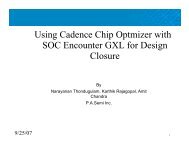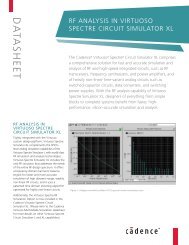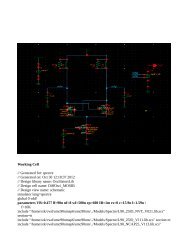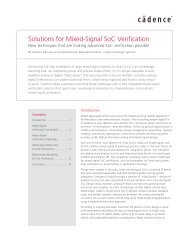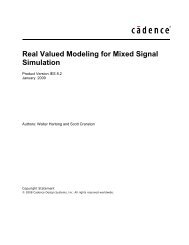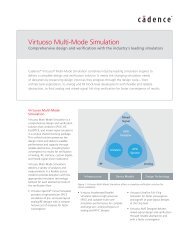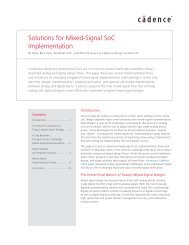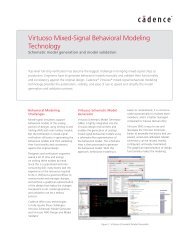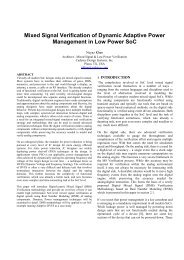Affirma Spectre DC Device Matching Analysis Tutorial - Cadence ...
Affirma Spectre DC Device Matching Analysis Tutorial - Cadence ...
Affirma Spectre DC Device Matching Analysis Tutorial - Cadence ...
You also want an ePaper? Increase the reach of your titles
YUMPU automatically turns print PDFs into web optimized ePapers that Google loves.
Example<br />
<strong>Affirma</strong> <strong>Spectre</strong> <strong>DC</strong> <strong>Device</strong> <strong>Matching</strong> <strong>Analysis</strong> <strong>Tutorial</strong><br />
dcmm1 dcmatch mth=1e-3 oprobe=vd porti=1<br />
model n1 bsim3v3 type=n ...<br />
+ mvtwl=6.15e-9 mvtwl2=2.5e-12 mvt0=0.0 mbewl=16.5e-9 mbe0=0.0<br />
In the above example, a dcmatch analysis is to be performed to investigate the<br />
3-sigma dc variation at the output of the current flowing through the device vd.<br />
The porti=1 specifies that the current is flowing through the first port of vd (vd<br />
has only one port obviously, thus porti=2 will be illegal). All device mismatch<br />
contributions less than 1e-3 * maximum contribution among devices to the<br />
output will not be reported. dcmm1 is the name of the analysis, which can be<br />
used to identify output among analyses. The mismatch (i.e. the equivalent<br />
mismatch current sources in parallel to all the devices that uses model n1) is<br />
modeled by the model parameters mvtwl, mvtwl2, mvt0, mbewl, and mbe0. The<br />
meaning of these parameters is described in the modeling section.<br />
The output of the dcmatch analysis is displayed like this:<br />
*********************************************<br />
<strong>DC</strong> <strong>Device</strong> <strong>Matching</strong> <strong>Analysis</strong> ‘mismatch1’ at vd<br />
*********************************************<br />
Local Variation = 3-sigma random device variation<br />
Release Date Back Page 9<br />
Close<br />
9






